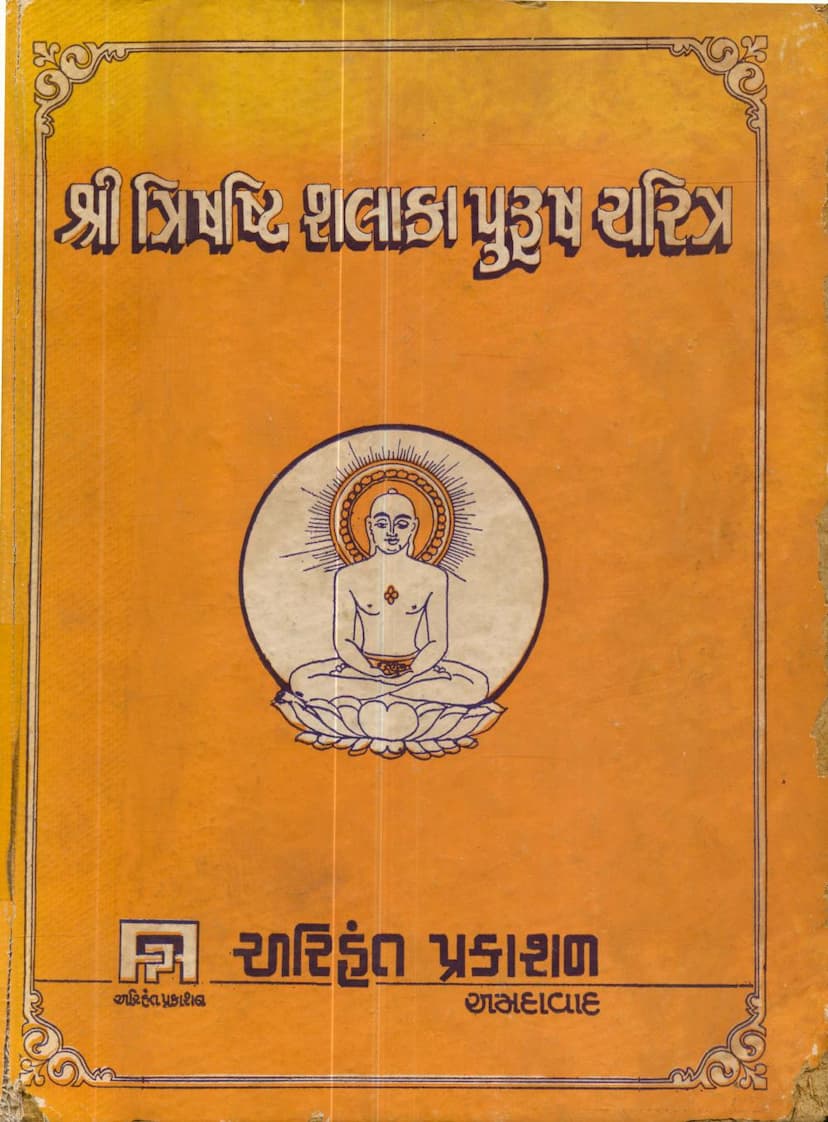Trishashti Shalaka Purush Charitra Part 04
Added to library: September 2, 2025

Summary
Here's a comprehensive summary of "Trishashti Shalaka Purush Charitra Part 04" by Jain Dharm Prasarak Sabha, published by Arihant Prakashan, based on the provided Gujarati text:
This volume, the fourth part of the Trishashti Shalaka Purush Charitra, contains the lives of prominent figures in Jain tradition, specifically focusing on Shri Adishwarji and Bharat Chakravarti, and Shri Ajitnathji and Sagar Chakravarti. It is presented as a Gujarati translation of the Sanskrit poem by the renowned "Kālkalasurya" Acharya Shri Hemchandracharya. The publication is a courtesy of Shri Jain Dharm Prasarak Sabha, Bhavnagar, and brought out by Arihant Prakashan, Ahmedabad.
The introductory sections (Pages 4-15) emphasize the importance of scriptures and the lives of great individuals in shaping any religion and culture. It addresses the modern tendency to dismiss religious texts and figures as "myths" or mere literary creations, arguing that such views stem from a materialistic, intellect-driven perspective that fails to grasp the deeper, spiritual reality. The preface highlights the profound loss to culture when the historical narratives within these texts are dismissed as imagination, especially in an era that claims to be scientific but has potentially created mechanisms for humanity's destruction and eroded faith. It calls for a resistance against these forces through unwavering faith, which allows one to perceive realities beyond the tangible, even across vast spans of time. The text posits that the "Trishashti Shalaka Purush Charitra" is a prime example of such literature, created by Acharya Hemchandracharya for the welfare of humanity, presenting the complete history of Jain culture and the lives of its 63 significant figures. It defines "Shalaka Purush" as those possessing the virtue of "Samyaktva" (right faith) and explains that the author has meticulously detailed the lives of these 63 individuals in Sanskrit verse, spanning 36,000 verses.
The Table of Contents (Page 13-15) outlines the structure of this particular volume (Part 10 of the larger work) which is dedicated to Shri Mahavir Swami. It details the 13 sargas (chapters) that cover:
- Sarga 1: The past lives of Shri Mahavir Swami, including his rebirths as Nayasar, Marichi, Vishvabhuti, and others, highlighting the acquisition of qualities and the eventual earning of Tirthankar Namkarma.
- Sarga 2: The birth and initiation of Shri Mahavir, including details of his marriage and the grand initiation ceremony.
- Sarga 3: The first six years of Shri Mahavir's spiritual wandering (vihār), detailing various hardships (upasargas) and encounters, including the story of Gosala.
- Sarga 4: The second six years of Shri Mahavir's wandering, continuing the accounts of hardships, the manifestation of his powers, and significant events like receiving Kevala Gyan (omniscience).
- Sarga 5: The attainment of Kevala Gyan by Bhagavan Mahavir, the establishment of the four-fold Jain congregation (Sangha), and the compilation of the twelve Angas and fourteen Purvas.
- Sarga 6: The narratives of King Shrenik and Konik, Meghakumar, and Nandishen, illustrating their lives and spiritual journeys.
- Sarga 7: The stories of Chillana, Konik, and Adra Kumar, showcasing their virtues and spiritual practices.
- Sarga 8: The accounts of Rishabhdatta, Devānanda, Jamāli, Gosala, and others, providing insights into their past lives, devotion, and eventual spiritual liberation or downfall. It also mentions the philosophical differences that arose with Gosala.
- Sarga 9: The narratives of Halik, Prasannachandra, Dadrankadev, and others, highlighting their spiritual paths and significant events in their lives, including the eventual Kevala Gyan of Prasannachandra.
- Sarga 10: The biographies of Dasharnabhadra and Dhannashalibhadra, emphasizing their righteous conduct and spiritual attainments.
- Sarga 11: The stories of Rohineya, Abhaykumar, Udayan, Chandpradyot, and others, detailing political events, personal struggles, and spiritual journeys, including Abhaykumar's strategic brilliance and Udayan's eventual renunciation.
- Sarga 12: The concluding part of this volume which covers events related to Vitatbhayapattan, Abhaykumar, Konik, King Chetak, King Udāyi, etc., and the eventual Nirvana of Bhagavan Mahavir.
The summary further elaborates on the detailed narratives within these sargas, particularly for Shri Mahavir Swami, covering his previous births, the circumstances of his conception and birth (including the divine intervention of Indra), his childhood activities, his marriage to Yashoda, and his eventual initiation into asceticism. It describes the severe austerities he underwent, the numerous obstacles and afflictions (upasargas) he faced from various beings and circumstances, and how he overcame them with equanimity and spiritual fortitude. The text highlights his attainment of Kevala Gyan, his teachings, the establishment of the Jain Sangha, and the subsequent events in the lives of his principal disciples. The narratives are rich with moral lessons, emphasizing the principles of Jainism like non-violence, truthfulness, and detachment.
The preface also touches upon the compiler's (Acharya Hemchandracharya's) profound scholarship in grammar, lexicography, poetry, and rhetoric, which lends exceptional quality to the narrative. The work is praised for its vast inclusion of characters, vivid descriptions of battles, military strategies, and the captivating portrayal of auspicious events like the birth celebrations of the Tirthankaras and the construction of the Samavasarana. The meticulous division of the 63 Shalaka Purushas across the ten Parvas is noted, with a detailed breakdown of which Purushas are covered in each part. The text also clarifies the concept of "Shalaka Purusha" and their predetermined paths towards liberation or other destinations based on their karma. The summary concludes by reiterating the profoundness and inspirational value of the "Trishashti Shalaka Purush Charitra" and encourages its reading as a spiritual endeavor.